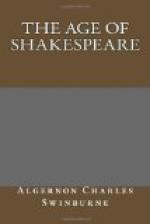In this earlier of the two plays extant which preserve the name of Cyril Tourneur the magnificent if grotesque extravagance of the design may perhaps be partly accounted for by the didactic or devotional aim of the designer. A more appalling scarecrow or scarebabe, as the contemporaries of his creator would have phrased it, was certainly never begotten by orthodoxy on horror than the figure of the portentous and prodigious criminal who here represents the practical results of indulgence in free thought. It is a fine proof of the author’s naturally dramatic genius that this terrific successor of Vanini and precursor of Diderot should be other than a mere man of straw. Huge as is the wilful and deliberate exaggeration of his atrocity, there are scenes and passages in which his daring and indomitable craft is drawn with native skill as well as force of hand; in which it is no mere stage monster, but a genuine man, plausible and relentless, versatile and fearless, who comes before us now clothed in all the cajoleries of cunning, now exultant in all the nakedness of defiance. But indeed, although the construction of the verse and the composition of the play may both equally seem to bear witness of crude and impatient inexperience, there is no lack of life in any of the tragic or comic figures which play their part through these tempestuous five acts. Even so small a figure as the profligate Puritan parasite of the atheist who hires his hypocrisy to plead against itself is bright with touches of real rough humor. There is not much of this quality in Tourneur’s work, and what there is of it is as bitter and as grim in feature and in flavor as might be expected of so fierce and passionate a moralist: but he knows well how to salt his invective with a due sprinkling of such sharply seasoned pleasantry as relieves the historic narrative of John Knox; whose “merry"[1] account, for instance, of Cardinal Beaton’s last night in this world has the very savor of Tourneur’s tragic irony and implacable disgust in every vivid and relentless line of it.
[Footnote 1: These thingis we wreat mearelie.—Works of John Knox, vol. i., p. 180.]




